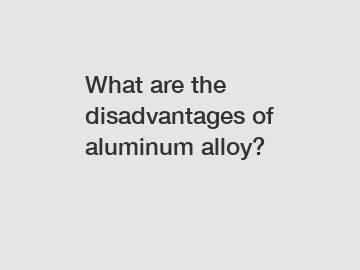What are the disadvantages of aluminum alloy?
Dec. 29, 2023
Aluminum alloy, a versatile material prized for its lightweight nature, superior strength, and corrosion resistance, revolutionized various industries. From aerospace to automotive, construction to consumer products, its remarkable properties have been leveraged for decades. However, like any other material, aluminum alloy is not without its drawbacks. In this blog, we will delve into the lesser-known disadvantages of aluminum alloy, shedding light on aspects that are often overshadowed by its numerous advantages.
1. Limited Structural Integrity:
While aluminum alloy possesses commendable strength-to-weight ratio, it may not be the ideal choice when structural integrity is paramount. Compared to other metals, such as steel, aluminum alloys tend to have lower stiffness and yield strength. This can be a disadvantage in applications that require high load-bearing capabilities or resistance to deformation over extended periods. In scenarios where structural rigidity is critical, alternatives should be explored to ensure optimal safety and longevity.

2. Vulnerability to High Temperatures:
Aluminum alloy, though resistant to corrosion, faces limitations when exposed to extreme temperatures. As the temperature rises, the material undergoes significant thermal expansion, leading to potential distortions and structural damage. Moreover, the melting point of aluminum alloy is considerably lower than that of steel, preventing it from withstanding extremely high temperatures. In applications where fire resistance is a decisive factor, alternative materials must be considered.
3. Susceptibility to Wear and Tear:
Despite aluminum alloy's durability, it is not invulnerable to wear and tear. Continuous exposure to heavy use, friction, and abrasive environments may result in surface damage, erosion, or pitting corrosion. This is particularly problematic in industrial settings, where machineries and equipment made of aluminum alloy can experience premature deterioration. Regular maintenance, protective coatings, or selecting more robust materials can help mitigate such issues.
4. Galvanic Corrosion:
Galvanic corrosion occurs when aluminum alloy comes into contact with dissimilar metals in a corrosive environment. Due to its position in the electrochemical series, aluminum alloy suffers accelerated corrosion when connected to materials with higher electrochemical potential. This often leads to localized corrosion, compromising the structural integrity and cosmetic appearance. Proper insulation or the use of protective measures, such as galvanic isolation or surface treatments, can help in preventing galvanic corrosion.
5. Cost and Availability:
Aluminum is the most abundant metal in the Earth's crust, making it readily available. However, the complex extraction and refinement processes required to transform bauxite into aluminum alloys can make it a costlier option compared to other materials. Additionally, the demand for aluminum alloy in numerous industries has also led to price fluctuations and supply-chain challenges. Budget constraints and availability issues should be considered while planning projects or choosing alternatives.
6. Environmental Impacts:
Despite aluminum's eco-friendly reputation, its production does have certain environmental repercussions. The extraction and refinement processes release greenhouse gases and consume significant amounts of energy. Furthermore, mining bauxite can have adverse effects on local ecosystems, including deforestation and water pollution. While aluminum is highly recyclable, the energy-intensive recycling process may still contribute to overall carbon emissions. Thus, a holistic approach must be adopted to balance the advantages of aluminum alloy with its environmental drawbacks.
Conclusion:
Aluminum alloy undoubtedly offers exceptional benefits, but it is essential to consider its disadvantages for a comprehensive understanding. From potential limitations in structural applications to vulnerability in extreme temperatures, wear and tear, galvanic corrosion, cost considerations, and environmental impacts, these factors deserve attention. By acknowledging the shortcomings of aluminum alloy, we can make informed decisions, exploring alternatives when necessary, and leveraging this remarkable material in a responsible and sustainable manner.
For more information, please visit Elevated Work Platform For Sale, Self-propelled Lifting Platform, Spider Lift Platform.
168
0
0

Comments
All Comments (0)